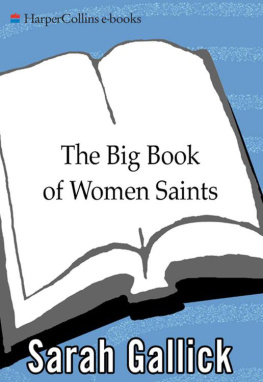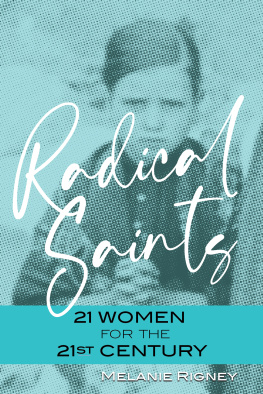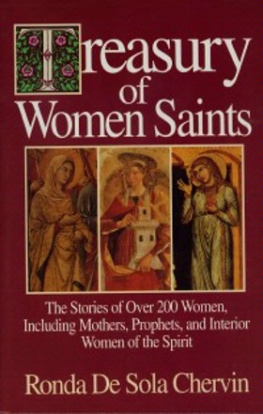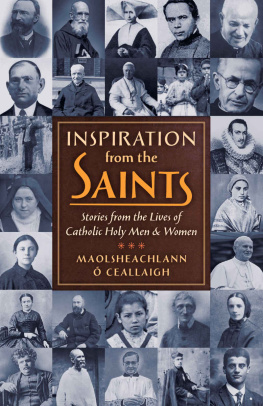This is a small payment on a debt that can never be repaid.
The single most important thing to know about the saints is that they were once people just like us. We are all called to be saints, but the saints answered that call fearlessly and completely. Those of us who make it into heaven will become part of their great company. We will never know the names of most of these men and women until we get there, but in the meantime the Church does single out some of them for special recognition and veneration by those of us who still struggle along in this world.
The more than five hundred notable women described in this book are among that illustrious company. Each is a canonized saint or blessed of the Catholic Church. Each lived her life to the fullest and triumphed over worldly challenges without sacrificing her soul. Each shared a unique quality that has been called the feminine genius. Pope John Paul II often saluted this feminine genius. In a 1995 encyclical, Evangelium Vitae (The Gospel of Life), he appealed to women to promote a new feminism, one that would reject the temptation to imitate the male model in order to affirm the true genius of women in every aspect of society.
The women saints include martyrs and mystics, rebellious daughters, loving wives and mothers, reformed prostitutes, restless visionaries and humble recluses, but all were blessed with a unique ability to influence the world for the better and an extraordinary capacity for love.
What Is a Saint?
The Catechism of the Catholic Church defines a saint as the holy one who leads a life in union with God through the grace of Christ and receives the reward of eternal life. The Church itself is called the communion of saints. Everyone in heaven is a member of this communion of saints.
From the earliest days of the Church, some of these faithful have been singled out for special recognition, or canonized, which means that the Church proposes them as models and intercessors to be venerated as saints.
How Saints Get That Way: The Canonization Process
The first Roman Catholic saints were mostly martyrs. They were first recognized by popular acclamation, which was later confirmed by the local bishops. The martyrs graves were considered sacred sites and churches were built over them, which led to the tradition of naming churches for saints.
By the tenth century, the process had become formalized and the ultimate decision about canonization resided with the pope in Rome. The first saint formally recognized by the Vatican was Ulrich of Augsburg, a pious bishop who was canonized by Pope John XV in 993. Ulrichs spiritual mentor, Wiborada of Saint Gall (May 2), became the first woman formally canonized by the Vatican, in 1047. (A reclusive bookbinder in a monastery famed as a center of learning, Wiborada predicted an invasion by the Hungarians and urged the monks to save the library before they saved her. She was martyred in 925 but the library she loved still stands in what is now St. Gallen, Switzerland.)
Since the twelfth century the pope has been the Churchs sole authority for canonizing saints. But not even a pope can make a saint. As Pope Paul VI explained at the canonization of Julie Billiart (April 8): We do not create, we do not confer saintliness, we recognize it, we proclaim it.
This proclamation comes only after a rigorous investigation by the Congregation for the Causes of Saints. A committee of judges, a canon lawyer and other high-ranking religious, the Congregation studies the life and death of the candidate. They pore over her writings and scrutinize the miracles said to have been worked by God through her intercession. This process used to take many years, even centuries, but it has been reformed and updated several times since 1983. Gone is the Defender of the Faith, better known as the Devils Advocate, who was dedicated to presenting all conceivable arguments against canonization.
The Congregation is still open to hearing negative information, however. One of Mother Teresas harshest critics, journalist Christopher Hitchens, was invited to share his experiences and insights with them and did.
Mother Teresa (September 5) was beatified only six years after her death, but there have been other fast-trackers. Francis of Assisi was canonized just two years after his death, and Pope Innocent IV had to be talked out of canonizing Clare of Assisi (August 11) at her funeral. Both Bridget of Sweden (July 23) and Elizabeth of Hungary (November 17) were canonized twenty years after their deaths. Thrse of Lisieux (October 1) had been dead only twenty-eight years when she was elevated to sainthood. Elzear was canonized in 1369 and his widow, Delphine de Signe (November 29), was still alive to attend the ceremony. It took almost fifty years for Maria Goretti (July 6) to be canonized, but she was so young when she died that both her mother and her repentant murderer attended her canonization in 1950.
The Three Steps to Sainthood
By far the best book about the process of saint-making today is Kenneth Woodwards Making Saints. What follows here is merely a summary of the three steps: recognition of heroic virtue, beatification, and canonization.
Recognition of Heroic Virtue.
An individual must be dead for five years before she can even be considered for recognition of her heroic virtue. This process is usually initiated by the bishop of her local diocese and the individual is then called a Servant of God. Her life and writings are closely examined until the investigators conclude that she practiced the theological virtues of faith, hope, and charity as well as the cardinal virtues of prudence, justice, temperance, and fortitude to a heroic degree. At that point the individual is declared Venerable, and the cause for her canonization is officially launched. Among the women currently in this group are Pauline Jaricot, founder of the Society for the Propagation of the Faith; Rose Hawthorne Lathrop, daughter of the novelist Nathaniel Hawthorne and founder of a religious order devoted to victims of terminal cancer; and Dorothy Day, founder of the Catholic Worker movement.
Beatification and the First Miracle.
The campaign is now taken up by the Congregation for the Causes of Saints, which is based in the Vatican. The Congregation appoints a postulator who leads the investigation into miracles attributed to the candidates intercession. Today these miracles are usually healings and cures. Such cures must be instantaneous, not expected and complete.
The miracles are not reserved for Catholics, however. In 1963 a Protestant laborer, Carl Eric Kalen, was miraculously healed through the intercession of Elizabeth Ann Seton (January 4) at a hospital in Yonkers, New York. This was accepted as a canonization miracle, and twelve years later, he attended the ceremony in Rome.
The Congregation also recognizes miracles in cases where the candidate has influenced an extraordinary event that cannot be explained by the laws of science. The Peruvian naval officer who saved his submarine crew through the intercession of Marija Petkovic (July 2) is such an example.
When civil and ecclesiastic investigations are completed, the Congregation can choose to recommend that the candidate be beatified. The pope can then choose to declare her Blessed, which means that she can be venerated on a local level and by her religious order. In Marija Petkovics case, for example, she is venerated in her homeland of Croatia, in Peru where she was a missionary, and by the Franciscan Daughters of Mercy, the order she founded.










